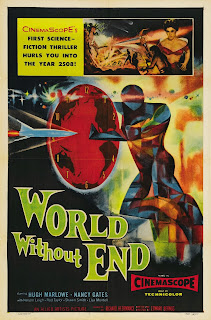Other films by Edward Bernds: Return of the Fly, Queen of Outer Space
Similar films: The Time Machine, Planet of the Apes
|
Director: Edward Bernds
Stars: Hugh Marlowe, Rod Taylor, Nancy Gates
Genre: Science Fiction, Post-Apocalyptic
A spaceship's crew is returning from a trip to Mars when something goes wrong and they find themselves transported to a post-apocalyptic future where mankind has been forced underground to survive. World Without End undoubtedly took inspiration from H.G. Well's classic novel The Time Machine (coincidentally, Rod Taylor who plays Herbert in this film later went on to star in the 1960 film adaptation of The Time Machine). Obviously it was Wells that pretty much invented the modern concept of the time-travel story, but the similarities go even further. In The Time Machine we see an advanced human race living on the surface of Earth and a savage mutated species living underground. World Without End sort of reverses this, but it's the same idea nonetheless: advanced humans live safely underground while savage beasts roam the surface. Also like in The Time Machine, the advanced humans in World Without End have lost their confidence and will to fight. World Without End perhaps lacks some of the powerful commentary and originality that the H.G. Wells novel had, but as far as time-travel tales go it gets the job done. When we look back on the science-fiction films of the 1950s most of us first think of the campy b-movies with low budgets and cheap effects. It's true that many sci-fi films of the 50s had very low budgets and because of the low budgets had almost always been in black-and-white and lacked a wide-screen format. Don't let the Technicolor in World Without End fool you: it's most certainly a low-budget b-movie. The film's poster proudly states that it's "CinemaScope's first Science-Fiction Thriller," but don't let this fool you either. While most 50s sci-fi was in black-and-white, plenty of larger-budgeted sci-fi movies like Destination Moon, When Worlds Collide, The War of the Worlds, This Island Earth, Forbidden Planet, et al were shot in color. So When Worlds Collide is far from being the first Technicolor sci-fi film. Nor is it the first sci-fi film shot in wide-screen, with that credit going to 20,000 Leagues Under the Sea from 1954. It's also not really a "thriller" like it claims to be. It's exaggerated and misleading poster only fits the film more neatly into the many sci-fi b-movies of its time. (Oh yeah, and that awesome looking crystal-like giant holding that giant clock on the poster? Not in the actual movie.) The reason World Without End was shot in Technicolor and CinemaScope despite having a low-budget and coming out in a time when most b-movies were in black-and-white is because Allied Artists, who produced the film, had a bad "poverty row" reputation that they wanted to shake. To do this they gave a little extra money to this film, allowing it to be shot in color and wide-screen and to exceed the 60-70 minutes runtime that many of the studio's other films had. Too bad there still wasn't enough budget for anything besides the technical aspects. Some of the special effects look very good. The spaceship scenes are visually engaging. The design and costume work of the one-eyed mutated beasts is also impressive; they look both grotesque and unique. Some of the other effects aren't quite as good. The giant mechanical spiders that the main characters encounter in a cave look terribly lifeless and rubbery. The sets and costumes of the underground society, though charming, have that very cheesy retro-futuristic look. They still look pretty good at times anyway. Edward Bernds directed this feature. He directed tons of b-movies throughout the 40s all the way to the 60s. Perhaps his most remembered work, along with a handful of Three Stooges movies, is Return of the Fly starring Vincent Price, which was a sequel to classic monster movie The Fly. If anyone has watched Queen of Outer Space or Valley of the Dragons, both directed by Bernds, then they may recognize the same mechanical spiders that were used in this film. (Again: not a big budget director.) Hugh Marlowe stars in here, who also starred in 1951's The Day the Earth Stood Still and later in Earth vs. the Flying Saucers. His performance isn't exactly good (according to the director Marlowe only got the role because he was willing to work for a very low salary, and he was often lazy and unprepared) but it's passable. The real star here is pre-fame Rod Taylor. This was his first major role and he does a great job. He'd later go on to star in films like The Time Machine, The Birds, and he even made an appearance in Inglorious Basterds. Another possibly recognizable face is that of the beautiful Nancy Gates. She does a good job as the ultra-mini-skirt wearing babe (it's no surprise that all the girls in here are not only beautiful but also dressed in very revealing clothing; Alberto Vargas, one of the most notable pin-up girl artists of all-time, worked on the costume and set sketches for the film). World Without End is an enjoyable film throughout. For a low-budget film it's extremely watchable. It features some interesting themes (even if most of them are ripped straight from Wells) and some cool special effects and set/costume design (even if most of the time it looks cheesy and dated). Its low budget certainly shows but at the same time its use of color and wide screen format help separate it from the countless other b-movies of the 50s. That doesn't necessarily mean it's the best 50s sci-fi has to offer--far from it. But solid nonetheless. Not terribly impressive compared to other works; merely enjoyable. |
Pages
▼


+title+screen.jpg)








No comments:
Post a Comment